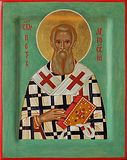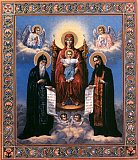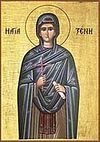

| Previous day | Next day |
| Old Style
May 3
|
Thursday |
New Style
May 16
|
| 2nd Week after Pascha. Tone 1. | No fast.
|
![]() Martyrs Timothy the Reader and his wife Maura, of Antinoe in Egypt (ca. 286).
Martyrs Timothy the Reader and his wife Maura, of Antinoe in Egypt (ca. 286). ![]() St. Theodosius, abbot of the Kiev Caves Monastery and founder of coenobitic monasticism in Russia (1074).
St. Theodosius, abbot of the Kiev Caves Monastery and founder of coenobitic monasticism in Russia (1074).
St. Peter the Wonderworker, bishop of Argos (ca. 928). Translation of the Dormition Icon of the Most Holy Theotokos from Constantinople to the Kiev Caves Lavra (1073). St. Theophanes of Vatopedi, metropolitan of Peritheorion (14th c.). Schema-abbess Juliana (1393) and Schemanun Eupraxia (1394), of the Monastery of the Conception in Moscow. St. Gregory, bishop of Rostov and Yaroslavl (1416).
New Hieromartyr Vladimir Izvolsky, archpriest, of Manchuria (1930).
“Svensk” Icon of the Most Holy Theotokos (1288).
Great-martyr Xenia the Wonderworker, of the Peloponnese (318). St. Ecumenius the Wonderworker, bishop of Tricca (4th c.). St. Mamai, catholicos of Georgia (744). Sts. Michael and Arsenius the Georgians (9th c.). St. Ansfried, bishop of Utrecht (1010). Martyr Paul of Vilnius, Lithuania (17th c.). New Martyr Achmed (Ahmet) the Calligrapher, at Constantinople (1682). St. Irodion, abbot, of Lainici Monastery (Romania) (1900). Martyrs Diodorus and Rhodopianus, deacon, at Aphrodisia in Anatolia (285-305). Finding of the relics of St. Luke of Mt. Steirion (953). Sts. Silas (1783), Paisius and Nathan (1784), monks of Putna Monastery (Moldova).
Thoughts for Each Day of the Year
According to the Daily Church Readings from the Word of God
By St. Theophan the Recluse

Thursday. [Acts 4:23–31; John 5:24–30]
And they shall come forth; they that have done good, unto the resurrection of life; and they that have done evil, unto the resurrection of damnation (John 5:29). This is how everything ends! As each river flows into its own sea, so the flow of each of our lives comes, at last, to a place according to its nature. Those who will be resurrected unto life will also be at the judgment; but the judgment will only seal their justification, and determine their life, while the others will be resurrected only to hear the condemnation of eternal death. Their life and death are characterized even now—because some do living deeds, while others do dead and deadening deeds. Living deeds are those which are done according to the commandments, with joy of the spirit, unto the glory of God; dead deeds are those which are done in opposition to the commandments with forgetfulness of God, to please oneself and one’s passions. Dead deeds are all which although in form may not oppose the commandments, are done without any thought about God and eternal salvation, according to some aspect of self-love. God is life; only what contains part of Him is alive. And so whoever has only dead and deadening deeds is bound directly for death, and on the last day will come out into the condemnation of death; but whoever has all living deeds is bound for eternal life, and on the last day will come and receive it.
Articles
 Martyr Timothy the Reader and his wife in EgyptSaints Timothy and Maura suffered for the faith during the persecution under the emperor Diocletian (284-305). |
 St. Peter the Wonderworker and Bishop of ArgosSaint Peter the Wonderworker, Bishop of Argos in the Peloponnesos, lived during the ninth and early tenth centuries, and was raised by pious parents. |
 Icon of the Mother of God of SvenThe Sven Caves Icon of the Mother of God was painted by Saint Alypius of the Caves (August 17). |





